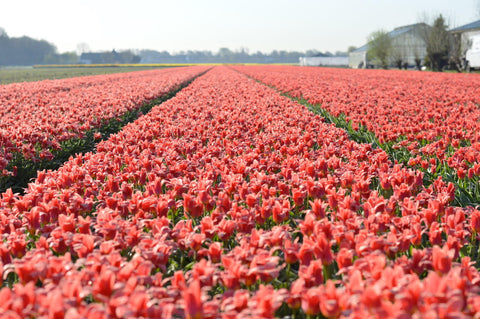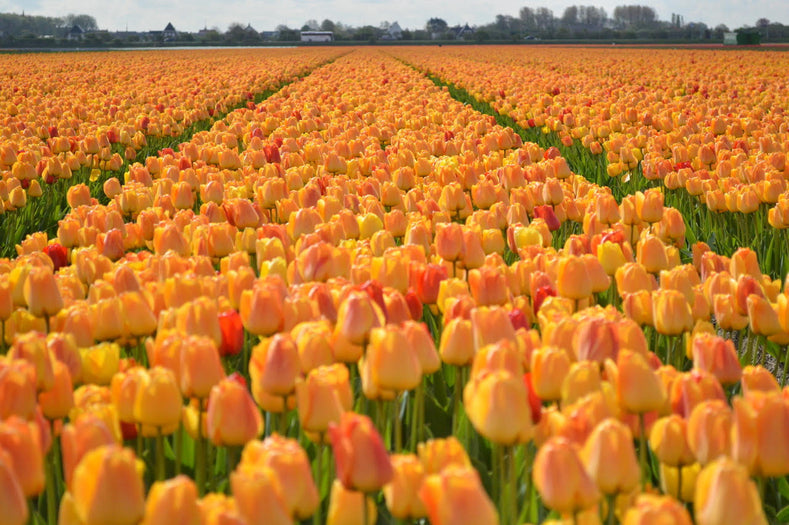Are Tulips Annual or Perennial?
A bulb that comes back every year, often with more blooms than before, is called a perennial. Great examples are daffodils and crocuses. Bulbs that only grown for one season are called annuals, which means that you have to plant new bulbs every year to get the same effect.
But, if tulips are perennials, like all the books and websites say, then why do they often not come back to show their luster a second or third season? What is going on here?
Perennial, but only in the right places
Well, as regal as tulips are, they are also a bit rebellious. Yes, they are officially perennials, but just not everywhere or for everyone. A tulip will happily come back year after year, but only if your garden happens to be in a village in the foothills of Nepal, or a town on the steppes of Armenia and Northern Iran. These places have very cold winters and hot dry summers, exactly what tulips need to perform at their perennial best.
Dutch soil and Dutch engineering.
But…if these places are so great for tulips, then why do all the best tulips come from Holland? This is where ingenuity and engineering come in to play. We Dutch tulip growers have two things working in our favor: beautiful sandy soil, and a century old tradition of being able to control water and make it do whatever we want.
This combination of soil and savvy means that we can create bulbs that return every year.
But the second part of this tulip trickery is a bit more involved: If you want to sell new bulbs every year, you also want your original bulb to multiply each season.
In order to entice tulip bulbs to do all of that for us, we put our bulbs through a complex process of heat and humidity treatments before we plant them in fall, trying to replicate the tulip’s native habitat as perfectly as possible, even when it’s almost 5000 miles away. We make the bulbs believe they have been through a hot, dry summer and an arctic winter. All of this requires expensive climate control systems, as well as serious know-how and experience.

Help your tulips come back next season
So, if you don’t live in Eastern Persia or Himchal Pradesh, your best bet is to buy new bulbs every year. That way you are guaranteed a spring full of the explosive colors and velvety blooms of your favorite tulips.
However, you can still do certain things to nudge some of your tulips away from their annual sulk, and give them a chance to show some perennial power:
- The first thing to consider is tulip variety. DutchGrown sells tulips that are specifically suited for naturalizing/perennializing. The most suitable breeds are tulips that have not been cross bred too much: Botanical tulips and their hybridized variations.
- As always, you want to plant your tulips in a well-drained area. The wetter the soil, the sooner the bulbs will succumb to fungus, disease and rot, so make sure water can drain away easily.
- To expose your bulbs to that bitter winter cold they need to experience to truly get going in spring, plant your tulips deep, about 8 inches.
- To spur on the first growth and get them to develop a strong and healthy root system, water your tulips right after planting.
- If you want your bulbs to gain maximum strength for their second (or even third) round, cutting off the flower heads at the right time is key. But don’t cut off the green foliage! Allow it to die and whither naturally. That way the energy that is stored in the foliage will gradually ‘flow back’ into the bulb, helping it to pack a punch next spring.
- A last way to support your reluctant perennials, is to fertilize their soil in fall ánd in spring. DutchGrown bulbs have more than enough food and energy in them to give you a great show in their first season, so they won’t need any fertilizing then. But if you want a second act, you need low nitrogen fertilizer, ideally special bulb fertilizer. In spring, when the first shoots stick out their heads, you can add a high-nitrogen, fast-release fertilizer, to give your returning favorites the final boost they need to do well, even when they are so far away from ‘home’.
Get Great Perennializers
A great example of returning tulips, where the hybrids are actually even stronger ‘perennializers’ than their originator species, are the Darwin Hybrids in red, orange, yellow, apricot, pink and two-tone colors. Other tulips that will react favorably to your perennializing help are Emperor Tulips, Triumph Tulips and Miniature Tulips. Buy them now, plant them in the fall, and get the best blooms coming spring (and the spring after that, and the spring after…)!

